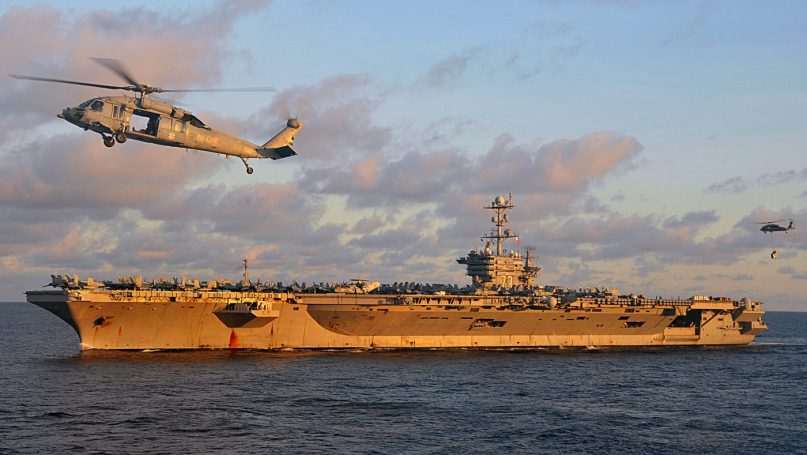
Asia’s New Battlefield: The USA, China and the Struggle for the Western Pacific
By Richard Javad Heydarian
Zed Books, 2015
Richard Javad Heydarian’s Asia’s New Battlefield: The USA, China and the Struggle for the Western Pacific, provides a comprehensive and well-timed analysis of the current battle for primacy and security in the Western Pacific. Heydarian states his aim to shed light on the complex evolution of the Sino-American relationship, which it is argued has oscillated between ‘strategic rivalry’ and ‘strategic cooperation’ [12]. Nowhere is this rivalry more apparent than in the western Pacific, a region characterised by an intensification of maritime territorial disputes.
Despite this great power rivalry, Heydarian argues that a hegemonic power struggle is by no means inevitable. Instead, China, the United States, middle powers and small powers need to forgo hedging behaviour, in favour of a strategy that balances engagement and deterrence. To establish a peaceful and prosperous Pacific community, Heydarian makes three key recommendations. First, enhanced confidence-building measures between the United States and China, to help prevent conflict and the escalation of tensions. Second, middle powers such as Japan, in conjunction with the regional institution the Association of Southeast Asian Nations (ASEAN), should enhance collaboration, facilitate effective conflict management, and seek a resolution to maritime territorial disputes that conform to international law. Third, small powers such as the Philippines should reduce their reliance on external powers, most notably the United States, by building their own defence capabilities and pursuing confidence-building measures vis-à-vis China.
Heydarian undertakes an in-depth analysis of domestic political considerations and balance of power dynamics before arriving at these conclusions. The Sino-American relationship is examined in detail, as is the predicament of the Philippines as a small power, and Japan and India as middle powers. Whilst readers unfamiliar with Cold War regional history will undoubtedly benefit from the information provided in the first and second chapters, these can be overly descriptive at times. It is really chapter three onwards that things get interesting, with some fascinating primary sources used to support the narrative. These include key interviews with regional experts such as Carl Thayer and Walden Bello, and the use of cables found on the Wikileaks website. The various conflicting legal arguments relating to maritime sovereignty disputes are also provided, and are given in such a way that they are easily accessible for a layman.
Considering Heydarian’s credentials as a Philippines analyst, it is perhaps unsurprising that the chapter on the regional role of small powers focuses primarily on the Philippines. Indeed, as a key claimant in the South China Sea territorial dispute, it would be remiss not to focus on the Philippines. However, this author would also have liked to see greater attention paid to the role of Vietnam. Like the Philippines, Vietnam is also seeking to pursue claims to maritime sovereignty, whilst trying to carefully navigate the Sino-American relationship. Some primary source information relating to Vietnam would have been a fascinating addition, beyond what has been included in the book.
Leading on from this, it is surprising the author does not explore the Vietnamese-Philippines relationship in more detail. Heydarian briefly suggests better-coordinated policies between these two countries to mitigate regional tensions. Arguably, this policy should be at the fore. Enhanced cooperation between these states, in conjunction with the United States, could help generate cohesion within ASEAN, which Heydarian correctly describes as ‘toothless’ [299], and largely an amalgamation of different Southeast Asian state interests. Indeed, recent evidence suggests greater attempts between the Philippines and Vietnam to coordinate a maritime dispute policy. Whilst it remains unclear whether this will be successful or not, its inclusion in the book would certainly have enhanced the overall work.
Heydarian argues that we are now witnessing the end of the unipolar moment, and the need, in light of this, to develop a truly multipolar Asia-Pacific community. The author adeptly utilises international relations theory to arrive at this conclusion. Indeed, theory is used throughout the book to support the analysis, and the various arguments made. However, despite this incorporation of theory, it is not explicit from the outset where the author positions himself with regards to the different theoretical arguments. There is an eclectic mixture of balance of power politics, state interests and nationalism. More could be done to clarify the balance between these competing ideas, and the varying impact on state behaviour and the outcome of events.
These suggestions aside, the final work is undoubtedly a comprehensive, compelling and well-written piece. The writing style is light and accessible, making it of use to a variety of audiences. It would certainly be of benefit to students, academics, policy-makers and any member of the general public with an interest in the Sino-American relationship, the role of regional states and maritime disputes in the Western Pacific. As such, it is definitely a welcome contribution to the field.